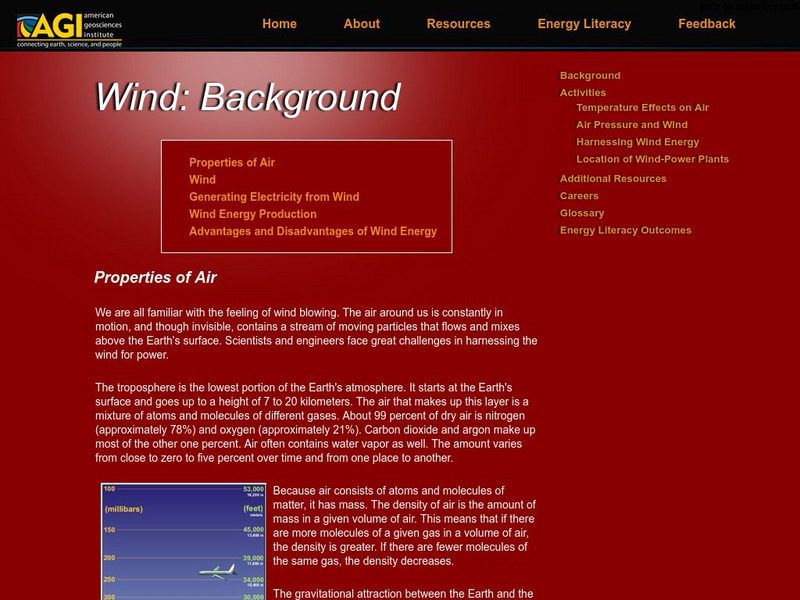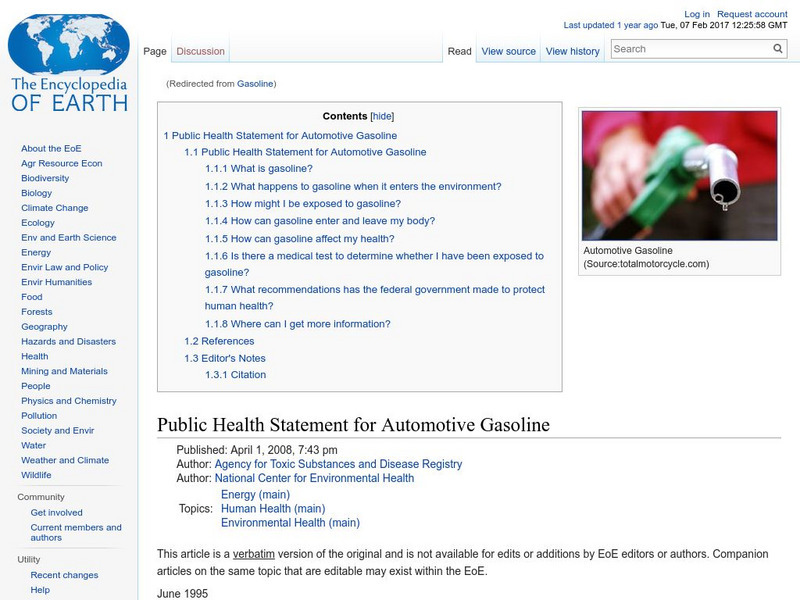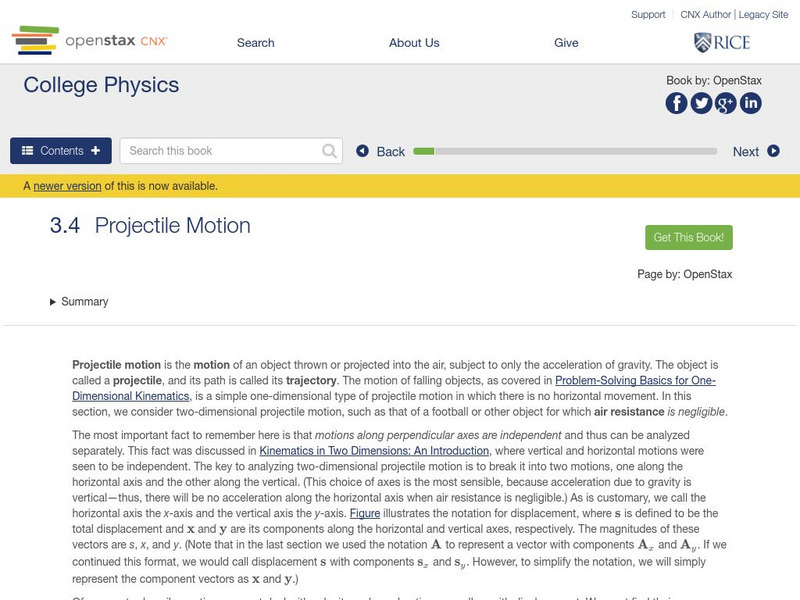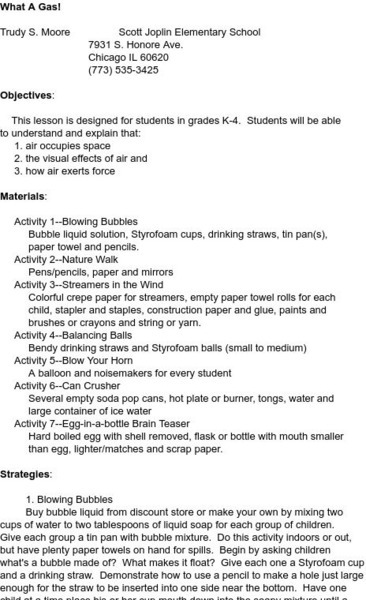TeachEngineering
Teach Engineering: What Is the Best Insulator: Air, Styrofoam, Foil, or Cotton?
That heat flows from hot to cold is an unfortunate truth of life. People have put a lot of effort into stopping this fact, however all they have been able to do is slow the process. Working in groups of three to four, students will...
American Geosciences Institute
American Geosciences Institute: Wind: Background
A reference page on wind. Learn about the properties of air that allow wind to form as well as how wind is used to make energy. The page also describes the advantages and disadvantages to wind energy.
Science and Mathematics Initiative for Learning Enhancement (SMILE)
Smile: Gases Lighter and Heavier That Air
Teachers, to demonstrate to the elementary student that some gases are heavier than others, this experiment uses Winnie the Pooh and balloons to do just that.
New York University
Nyu: Welcome to Water
Educational resource invites users to understand the properties of water by first examining what water is and how we use it and then leads users to further information on the three states that water can exist.
US Geological Survey
U.s. Geological Survey: Greenhouse Gases [Pdf]
Lesson plan in which learners observe and contrast thermal properties of three major greenhouse gases. Using simple, readily available materials, students collect temperature change over time for dry air, water-saturated air, carbon...
Encyclopedia of Earth
Encyclopedia of Earth: Petroleum: Gasoline
Explains what gasoline is and the different terms used for it, describes how it is produced, and what effects different properties of a gasoline can have on its performance. Also discusses how the composition of gasoline varies depending...
Web Elements
Web Elements Periodic Table: Nitrogen
Lots of valuable information on nitrogen, its properties and some of its uses and compounds.
TeachEngineering
Teach Engineering: Environment
Through 10 lessons and more than 20 hands-on activities, students are introduced to the concept of an environment and the many interactions within it. As they learn about natural and human-made environments, as well as renewable and...
University of Virginia
University of Virginia: Bell Jar Demonstration
A bell jar is evacuated to show the properties of a vacuum and air pressure. Pictures and a description of how to perform the demonstration are given.
OpenStax
Open Stax: Projectile Motion
The following interactive helps students understan how to identify and xplain the properties of a projectile, such as acceleration due to gravity, range, maximum height, and trajectory. They will determine the location and velocity of a...
Science and Mathematics Initiative for Learning Enhancement (SMILE)
Smile: What a Gas!
In this lesson plan, students will understand and explain that air occupies space, visual effects of air and how air exerts force.
PBS
Pbs Teachers: Zoom Vehicle
Explore forces of motion and properties of gasses by building a vehicle that runs along a string track powered by air pressure.
American Chemical Society
Middle School Chemistry: Chapter 1: Solids, Liquids, and Gases
Five exemplary chemistry lessons about the three states of matter complete with handouts and animations.
TryEngineering
Try Engineering: Pollution Patrol
Students will work in teams to design and construct outdoor air pollution detectors from everyday items. They will then test the designs for presence of pollutants in the air and communicate their results to the class.
Other
Virtual Chembook: Density Applications With Gases
DENSITY is a physical property of matter, as each element and compound has a unique density associated with it. Density defined in a qualitative manner as the measure of the relative "heaviness" of objects with a constant volume. For...
BBC
Bbc: Gcse Bitesize: Predicting Chemical Reactions
This lesson focuses on predicting chemical reactions using The Group 1 elements in the Periodic Table are known as the alkali metals. They include lithium, sodium and potassium, which all react vigorously with air and water. It provides...
Curated OER
Journey North Cluster Icon (8K)
Interesting site with links to activities about wind and air in many forms. Browse the different activities and investigations on the properties of air on the toolbar to the left of the page.
Curated OER
Cluster of Journey North Images (37K)
Interesting site with links to activities about wind and air in many forms. Browse the different activities and investigations on the properties of air on the toolbar to the left of the page.
NASA
Nasa: Beginner's Guide to Aerodynamics
Includes exhaustive information and a wealth of activities pertaining to aerodynamics and the physics of flight.
PBS
Pbs Kids: Dragonfly Tv Do It: Carbon Dioxide
PBS site offers an experiment kids can do at home to see how carbon dioxide can put out burning candles.
How Stuff Works
How Stuff Works: How Helium Balloons Work
This article explains how helium is able to keep balloons afloat in the air. Compares them to how hot air balloons work. Includes a video, and some activities to try for testing the principles being discussed.
Chemicool
Chemicool: Nitrogen
This site from Chemicool provides a set of data tables summarizing basic chemical and physical properties of nitrogen.
PBS
Pbs Teachers: Bottle Fountain Experiment
Demonstrate how heating expands air molecules by constructing a bottle fountain powered by air pressure.
Other popular searches
- Air Properties
- Science Properties of Air
- 4 Air Properties
- Properties of Air Powerpoint
- 5 Properties of Air
- Kindergarten Air Properties
- Air Properties Stations






![U.s. Geological Survey: Greenhouse Gases [Pdf] Lesson Plan U.s. Geological Survey: Greenhouse Gases [Pdf] Lesson Plan](https://d15y2dacu3jp90.cloudfront.net/images/attachment_defaults/resource/large/FPO-knovation.png)












